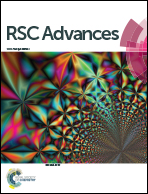Synthesis and characterization of a highly stable poly (3,4-ethylenedioxythiophene)-gold nanoparticles composite film and its application to electrochemical dopamine sensors†
Abstract
In this work, a highly stable nanocomposite film based on embedding gold nanoparticles (nanoAus) into a poly(3,4-ethylenedioxythiophene) (PEDOT) modified Pt electrode was fabricated and explored for dopamine sensing. The PEDOT film was synthesized in ionic liquids electrolyte-1-butyl-3-methylimidazolium tetrafluoroborate ([bmim][BF4]). Citrate coated nanoAus were immobilized on the polymer matrix via electrostatic interactions to facilitate the mass transport and weaken the capacitive current. This modified electrode took advantage of the high stability and excellent permselectivity of PEDOT, and exhibited a wide linear response to dopamine from 6.0 × 10−6 to 0.013 M. The detection limit was 0.2 μM (s/n = 3) and the amperometric response time was 2.5 s with chronoamperometry. Over the 8 months period of this study, the nanocomposite modified electrode still retained 85% of the original current response to dopamine. The highly stable modified electrode with improved sensitivity and selectivity could provide an ideal matrix for commercial applications.


 Please wait while we load your content...
Please wait while we load your content...